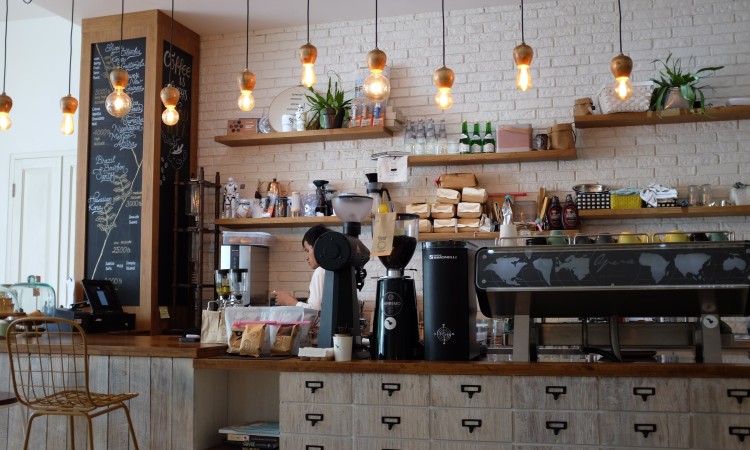Shopfitting. Design challenges and how to solve it?
What’s a Shopfitting?
Shopfitting is the process of planning and designing a shop layout. But there’s more to it. Shopfitter has an ability to design the interior, and to create a particular look, or feel inside an outlet. If he do it well, the space can provide a cozy restaurant atmosphere, or “scream” – FASHION in clothing shop.
Moreover, it also includes the installation of equipment, including racking and shelving for display purposes. There are various areas of shopfitting:
- Retail shops, Leisure Centers;
- Bars, Restaurants and Food outlets;
- Hotels, Offices;
- Grocery stores;
- Electronic stores, Fashion outlets;
In the past, shop fitting mainly consisted of installing shelves, counters and other basic furniture. Business owners saw these things as a place to store and display merchandise, and that was the only function of it. Furthermore, they weren’t considering shopfitting as an important part for businesses. However, nowadays, most retail businesses understand the importance of modern, smart and attractive presentation. Therefore, to keep it fresh and modern, retail shops change their layout and style on quite a regular basis.
Shopfitting involves the ability to design a store, execute planning, draw up layouts and install equipment, fittings, signage and furniture for shop to create a particular aesthetic appeal. It starts with a survey in order to measure the space of the outlet. When shopfitter has a plan on his hands, the design process can start. While, some might ask of your help, orther clients have their own visions of how the outlet should look like. Moreover, they may have drawings that are prepared by an interior designer. This means, that the shopfitter has to combine the clients vision, his own seeing and designers work. When all parties achieve a common vision and put it on the paper, shopfitter must arrange all materials and install everything according to specifications.
Once the shopfitting is complete, stock can be delivered and displays put together. Voila! You are ready for grand opening.
Shop furniture design challenges
Typical problems of the shop fitters is the need to combine different materials like metal, wood, plastic, glass etc. Moreover, the shape of furniture in modern outlets is quite complex. That is because of unusual equipment and the need to have some manufacturer brand signature. Because of unique material and shape combination designers are forced to use custom made joints and hardware.
Second challenge would be – last moment changes appears, because of different factors. Shopfitter, has to be flexible enough, to be able to adjust his plans to suddenly risen obstacles.
Last but not least – it’s a must to have connection with a floor plan. Nowadays some of the shops are located in complex architectural buildings as old factories, lofts, etc. therefore in some cases only ground plans is not enough for the design. In these cases, designer use 3D volumetric laser. Also, this technology is known as point cloud. Good cad system can use point cloud as a reference geometry.
Design-project creation:
Step 1:
- Site visiting with the customer, finding features and characteristics, measuring space, making measurements, photo/video.
- Analysis of the characteristics of the object.
- Setting up the zones according to the design, that client wants.
- Development of different variations of the project with retail store equipment arrangement.
Step 2:
- After reaching a common understanding, experts can start working on the development of variations of design. They form zones, according to customer needs and work on personalized design projects.
Step 3:
- 3D visualization – it’s photographic image of the project, to present to the client. Note, that even on this stage, the concept still can change, for instance: because materials do not match lighting.
[Best_Wordpress_Gallery id=”5″ gal_title=”Shopfitting”]
Requirements you should have for your CAD
Now as we can see, there’s quite a few needs the designers has and not too many specialized shopfitting software in the market. Usually this modeling area rises quite high requirements for graphical engine of a CAD system.
Firstly, you need to have a possibility to create custom shapes. That‘s why designers use softwares like AutoCAD, 3D Studio MAX, Google Sketch Up, Autodesk Inventor, Solidworks, etc.
However, this list gets shorter as soon as shopfitter discover a need to use parametric design, in order to have options to make parametrical changes. For example – sudden requirement to change the height of all plinths at once, because the shop mall decided to buy different shopping carts.
Third important point to consider is CAD system ability to exchange data in various formats.
As you may already guessed, working with shop interior does not stops at the design process. In order to start a manufacturing process, shopfitter has to prepare and calculate all parts.
BOM
Firstly, Cad system must be able to prepare the bill of materials (BOM). Considering tons of small, but important nuances, (such as precise measurements of a workpieces, grain direction, edge banding thickness, technological oversized etc.) composite and multilayer parts must be exploded in BOM views, to calculate precise amount of materials.
Drawings
As one says: one drawing is better than a thousand of words. Drawings is quite important part of the information preparation, which also requires a lot of efforts. Model can be precisely build, however one mistake in the drawing can turn into a big problem on assembling stage. Especially, when you think of the facts, that different contractors make a different parts of the shop. In the end those parts will have to connect precisely in one interior. Moreover, in order to create a precise drawing, shopfitter must dedicate quite a lot of time for this job.Good CAD system must be able to automate view creation and annotation placements. Moreover, changes in the model must be immediately reflect in the drawings, making them current. Otherwise you may face with ironic, but not funny situation, when you have correct model but assembling team are unable to fit things together.
CNC
When all the measurements are done it’s time to make a CNC technologies for all the parts. This is quite routine process causing a lot of debates about, who is responsible of the final result: CNC operator or store designer. Because of the complex shape of parts documentation requires a lot of time and attention. Usually people from CNC shop are going for consultation to the designer department or vice versa. Therefore, modern shop fitting programs must automate drawing and CNC program preparation process. If CNC programs are made automatically, there’s no need to prepare drawings for each single part, and designer can focus his attention on assembling drawings. Because of lot’s of technical and creative nuances there are moment, computers are helpless to make assembly guides automatically.
Design changes
Sometimes it happens, that design changes occurs even on the manufacturing preparation stage, because it turns out, that there’s some manufacturing problem. For instance there is a need to reduce the size of some of the parts by few centimeters because they don’t fit on the workpiece. Or because of CNC center limitations it is impossible to process the part. It is very hard to do model adjustments, if model is not parametric. Changes in single part causes a domino effect in all connected elements, therefore good CAD systems must be able to handle this situation automatically. Furthermore, designers should be protected of reworks or manual calculations, because of design changes only then they can produce high quality designs. Otherwise they will try to optimize other steps of the process for instances simplify the design to make it easy to calculate or produce.
Collaboration
Usually there are a few teams, which make shop equipment. For instance, one team makes metal frames, another takes care of furniture, third makes the electrical connections etc. However, all the tasks must be synchronized and managed in one central location. As a solution for managing these tasks, there is PDM (product data management ) systems. Good CAD systems must have an option to seamlessly exchange data with PDM. Moreover, PDM system must ensure that model changes in any stage affects all connected areas. For instance: change in the part are shown in the assembly, in the drawings and in the annotations, also current information is placed to PDM.
To sum up, these should be the basic requirements for the tool you choose. At first glance it might look as pricey solution, but soon you’ll find that it actually helps to save a lot of money. Therefore, give it some time to do the research before deciding, which software to choose.


